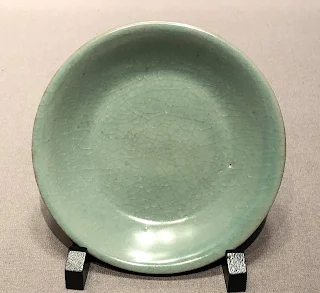These are celadon potteries which used to be owned by Yasunari Kawabata, a Nobel prize winning Japanese author, but were donated to, and therefore are currently on show at, Tokyo National Museum.
 |
| Dish, celadon glaze, in 11th to 12th century Northern Song dynasty |
 |
| Bowl, celadon glaze, in 12th to 13th century Southern Song dynasty |
The bowl (second photo) is Longquan ware in the 12th to 13th century, made in Lishui prefecture in southwestern Zhejiang Province in the south of China. This is also called "kinuta celadon (砧青磁)" in Japan.
The best quality celadon produced in Zhejiang Province during the Southern Song period is called "kinuta celadon" in Japan, named after a celadon flower vase "Kinuta" also made in Zhejiang Province and owned by Sen no Rikyu (千利休), one of the most influential Japanese tea masters. The term "kinuta" originally means a wooden roller which was used in China, Korea, and Japan to press out the wrinkles of laundered clothes and soften them. Two women, facing each other across a smoothing stone and kneeling on the floor, beat out a rhythm on the cloth. The tea master is said to have compared crazing (hairline cracks) on the celadon vase to the sound made when "kinuta" or the wooden roller hits the cloth on the stone.
A Japanese TV show referred to celadon pottery as jewellery. Akutagawa prize-winning (i.e., Japan's most prestigious literary award) author Yoshiko Shibaki wrote a novel titled "Celadon Kinuta (青磁砧)" depicting a father and his daughter, both of whom are obsessed with celadon. I feel now I am getting closer to their world.
For more on celadon, read my another post "Celadon in 16 Forms"!
東京国立博物館に並んで陳列されていた青磁。両方とも川端康成旧蔵品です。上が北宋時代、下が南宋時代の青磁です。
下の方は「砧青磁」とも呼ばれているとのこと。以前から「砧青磁」て何かなと思っていたので調べたところ、千利休が持っていた南宋時代の花入れが「砧」と呼ばれていたので、南宋時代の品質の高い青磁を「砧」と言うようになったとのこと。ちなみに「砧」は洗濯物の皺を伸ばす木の棒のことだったんですね。全く知りませんでした。
NHKの「美の壺」では青磁を宝石に例えていました。そして日本の女流作家で私の一番好きな芝木好子は青磁に魅せられた父と娘を描いた「青磁砧」という作品を書いています。以前は、青磁にそこまで没頭する心情が理解できませんでしたが、今は共感を覚えるようになりました。
NHKの「美の壺」では青磁を宝石に例えていました。そして日本の女流作家で私の一番好きな芝木好子は青磁に魅せられた父と娘を描いた「青磁砧」という作品を書いています。以前は、青磁にそこまで没頭する心情が理解できませんでしたが、今は共感を覚えるようになりました。
16個の青磁について書いた「いろんな青磁」も是非お読みください。


0 件のコメント:
コメントを投稿